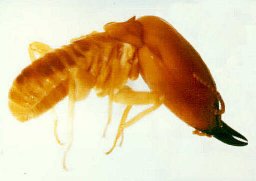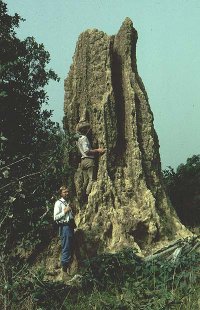|
HOME |
|
|
HOME |
|
Macrotermes bellicosus

Insects, including termites, are the most successful group of animals in the world today. Termites have been on Earth for over 50 million years. Some of their fossils date back to the Oligocene, Eocene, and Miocene periods. They have evolved into many different species (nearly three thousand!).The word 'termites' comes from the Latin word 'tarmes'. The Latin word was given to a small worm that makes holes in wood.
Macrotermes bellicosus is an African mound building termite. It has a highly developed social caste system which includes workers, soldiers, and ones that reproduce. It helps the process of decomposition by eating away at things.
 Termites of this family are well known as the builders of nearly all
the large termite mounds of tropical Africa. The mounds sometimes
have a diameter of 30 meters.
Termites of this family are well known as the builders of nearly all
the large termite mounds of tropical Africa. The mounds sometimes
have a diameter of 30 meters.
Young mounds are roughly circular in shape and often highly irregular. Areas of new growth have a characteristic "bubbly", appearance and when young, the whole mound may look like this. Very young mounds have no openings.
Many mounds, both dead and alive, have plants growing on them.
The structure of the mounds can be very complicated. Sometimes on mature mounds, in order to get good ventilation, the M. bellicosus will construct several shafts leading down to the cellar located beneath the nest. The average diameter of the shafts of the M. bellicosus is about two centimeters, but often they are higher than wide. The number of shafts can also increase as the nest grows larger.
The M. bellicosus termites live in colonies but really they are more like families. As far as entomologists know, they are the most sophisticated families ever to evolve in the universe. The termite colony has three separate stages: juvenile, adult, and senile. The survival of their species depends on their caste system.
The smallest in size, yet most numerous of the castes are the workers. They are all completely blind, wingless, and sexually immature. Their job is to feed and groom all of the dependent castes. They also dig tunnels, locate food and water, and build and repair the nest.
The soldier's job is to basically defend the colony from any unwanted animals. Soldiers have larger heads that are longer and wider than that of the workers because it contains more muscle. The soldiers can not feed themselves and must rely on the workers for this. The Macrotermitinae are mainly all females.
When the large soldiers of Macrotermes attack they emit a drop of brown, corrosive salivary liquid which spreads between the open mandibles. When they bite, the liquid spreads over the opponent like poisonous glue.

Finally, there are the reproductives. They include the king and the queen. The queen can sometimes grow up to six centimeters long while the lower classes are generally less than one centimeter. The sole role of the king is to provide the queen with the sperm needed to fertilize her eggs. The king looks like the queen in appearance. One difference between them is the size of the queen's abdomen once it is swollen with eggs. Her abdomen can hold a capacity of as much as ten milliliters of eggs, making it the largest of all individual social insects. The queen of the M. bellicosus can sometimes live as long as ten years. Termite reproductives have wings of equal size, which is where the Order name 'Isoptera' originates. The Greek word 'isos' means same and 'ptero' means wings.
Termites are very important in tropical ecosystems. They are probably the most important animals contributing to the decomposition processes. The M. bellicosus eats mainly dead wood. Termites also contribute to the tropical ecosystem by providing food and shelter to an amazing number of associated organisms.
We may think of termites as pests, but ninety percent of termite species are considered helpful. Their roles in breaking down wood and turning, aerating and enriching the soil are very important.